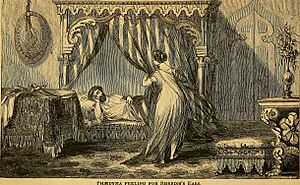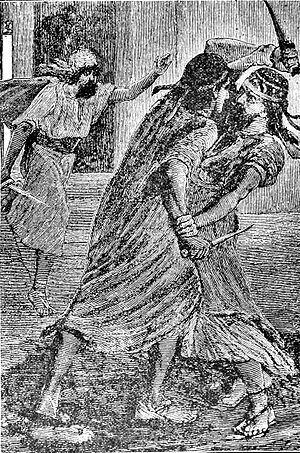Bardiya facts for kids
Quick facts for kids Bardiya𐎲𐎼𐎮𐎡𐎹 |
|
|---|---|
|
|

Portrait of the Achaemenid ruler toppled by Darius, as appearing on the Behistun inscription: he was either the legitimate Bardiya, or, as claimed by Darius, an imposter named Gaumāta.
|
|
| King of Kings of the Achaemenid Empire, Pharaoh of Egypt |
|
| Reign | 522 BC |
| Predecessor | Cambyses II |
| Successor | Darius the Great |
| Burial | 522 BC |
| Spouse | Phaedymia |
| Issue | Parmys |
| Dynasty | Achaemenid |
| Father | Cyrus the Great |
| Mother | Cassandane |
| Religion | Zoroastrianism |
Bardiya (also known as Smerdis) was a prince of ancient Persia. He was the son of Cyrus the Great and the younger brother of Cambyses II. Both his father and brother were powerful Persian kings.
Bardiya's story is a bit of a mystery. He either ruled the Achaemenid Empire for a few months in 522 BCE, or someone pretended to be him. This person was a priest called Gaumata. This mystery is a big part of ancient Persian history.
Contents
Who Was Bardiya?
Bardiya is known by different names in old historical writings. In the famous Behistun inscription by Darius the Great, his Persian name is Bardiya. The Greek historian Herodotus called him Smerdis. Another writer, Ctesias, called him Tanyoxarces.
In English history books, he was often called Smerdis. But more recently, historians prefer to use his Persian name, Bardiya.
The Traditional Story of Bardiya
The most common story about Bardiya comes from several old sources. These include the Behistun inscription and writings by Herodotus. They all agree that a person pretending to be Bardiya was overthrown by Darius I and other nobles. Darius then became king.
Bardiya's Family and Early Life
Bardiya was the younger son of Cyrus the Great. He was the full or half-brother of Cambyses II. According to some accounts, his father Cyrus made Bardiya a governor (called a satrap) of some eastern provinces before he died.
The Secret Death of Bardiya
According to Darius the Great, his brother Cambyses II secretly killed Bardiya before going to Egypt. However, Herodotus tells a different story. He says Bardiya went to Egypt with Cambyses. But Cambyses later sent him back to Susa because he was jealous of Bardiya's skill with a special bow.
Herodotus then says Cambyses had a dream that Bardiya would take his throne. Because of this dream, Cambyses sent a trusted helper, Prexaspes, to Susa to kill Bardiya.
The Impostor King
Most people did not know that Bardiya had died. So, in the spring of 522 BC, a man pretended to be Bardiya. He announced himself as king on a mountain near the Persian town of Paishiyauvada.
Darius claimed this impostor's real name was Gaumata. He was a Magian priest from Media. Other historians give different names for the impostor, like Oropastes or Sphendadates.
The rule of Cambyses had been harsh, and he had been away in Egypt for a long time. Because of this, many people, including Persians and Medes, accepted the new king. The impostor king even offered a three-year tax break, which made him popular.
Cambyses started to march back to fight the impostor. But he died in the spring of 522 BC. Before he died, he supposedly confessed to killing his brother and explained the trick. But people didn't believe him.
The impostor king ruled for seven months over the entire empire. He moved the government to Media.
The Nobles' Plan
A group of Persian nobles soon realized their new ruler was not the real Bardiya. Seven nobles planned to kill him. They surprised him at a castle in Nisa and stabbed him to death in September 522 BC. One of these seven nobles, Darius, was then made king.
The main historical sources don't agree on all the small details or names. But they all show Gaumata (or Pseudo-Smerdis) as an impostor. He took the throne by pretending to be one of Cyrus the Great's sons.
Herodotus' Detailed Account

Herodotus tells a longer version of the story. While in Egypt, King Cambyses became mentally unstable. He was jealous of his brother Smerdis (Bardiya). So, he sent Smerdis back to Persia and then had him secretly killed.
Only a few people knew Smerdis was dead. One was Patizeithes, a palace manager. This manager had a brother who looked very much like Smerdis, and his name was also Smerdis. The manager put his brother on the throne. This false Smerdis kept his identity a secret by not letting anyone who knew the real Smerdis get close to him.
Cambyses learned about the false Smerdis. He knew the real Smerdis was dead, so he understood the trick. Cambyses prepared his army to return to Susa. But he accidentally hurt himself with his sword and died a few days later.
The false Smerdis continued to rule. He gained support by giving people a three-year break from military service and taxes.
However, a nobleman named Otanes suspected the king was not the real Smerdis. He thought the king was the Smerdis whose ears Cyrus had ordered to be cut off as punishment. To check, Otanes asked his daughter, Phaidyme, to check the king's ears. Phaidyme was part of the royal household and could get close to the king. One night, while the king was asleep, she confirmed he had no ears.
With his suspicions confirmed, Otanes gathered six other noblemen. They planned to get rid of the false Smerdis. Darius joined their group. The seven conspirators stormed the king's rooms. Darius and Megabyzus killed the false Smerdis.
After things calmed down, the seven nobles discussed what kind of government they should have. They decided on a monarchy (rule by one king). They held a contest: whoever's horse neighed first after sunrise would become king. Darius cheated and became king.
Ctesias' Account
Ctesias' story is a bit different. King Cyrus, before he died, made his older son Cambyses king. He made his younger son, Tanyoxarces (Bardiya), governor of some eastern provinces.
Soon after Cambyses became king, a man named Sphendadates told Cambyses that his brother Tanyoxarces was plotting against him. Sphendadates looked a lot like Tanyoxarces. He suggested he could take the prince's place. Cambyses agreed, and Tanyoxarces was killed. Sphendadates then pretended to be Tanyoxarces and became governor.
Five years later, Cambyses died. Sphendadates (the fake Tanyoxarces) returned to the capital and became king. But a trusted friend of Cambyses, Izabates, knew about the killing of Tanyoxarces. He exposed the trick. Then, seven noblemen, including Darius, planned against Sphendadates. They got into the palace and killed him. They then held the horse-neighing contest, and Darius became king through a clever trick.
What Do Modern Historians Think?
Many modern historians don't fully believe Darius's story. They think the person who ruled for a few months was the real Bardiya. They believe Darius invented the story of an impostor to make his takeover of the throne seem right.
It would have been very important for Darius, who didn't have a clear right to the throne, to create a story about an evil impostor. This would justify his actions. There are some parts of the official story that seem unlikely. For example, the impostor looked so much like the real Bardiya that most of his wives didn't notice the difference, except for Queen Phaidyme. Also, Darius often accused his enemies of being impostors, which makes some historians wonder if he used this tactic often.
What Happened Next?
After the death of the false Bardiya, another person named Vahyazdāta claimed to be Bardiya. He started a rebellion against Darius in eastern Persia. He was very successful at first, but Darius eventually defeated him. Vahyazdāta was captured and executed.
The real Bardiya had only one daughter, named Parmys. She later married Darius the Great.
Some old contracts from Bardiya's short reign have been found in Babylonia. Darius claimed that Bardiya destroyed some temples and took people's animals and homes. Darius said he later fixed these problems when he became king.
The death of the false Bardiya was celebrated every year in Persia with a festival called "the killing of the magian." During this festival, no magian (priest) was allowed to be seen.
Bardiya in Stories
The story of Bardiya has appeared in books. For example, Gore Vidal's novel Creation suggests that the person who ruled was the real Bardiya.
The "impostor Magian Smerdis" is also mentioned in a short story by Jorge Luis Borges, Tlön, Uqbar, Orbis Tertius. He is used as a symbol in that story.



